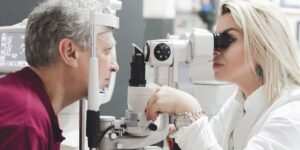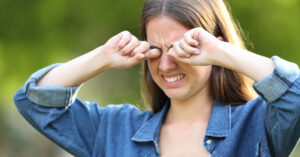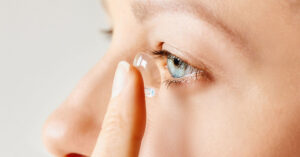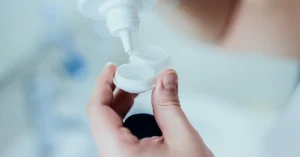Understanding Toric Contact Lenses
When it comes to vision correction, toric contact lenses are specifically designed to address the needs of individuals with astigmatism. Astigmatism is a common vision problem caused by an irregularly shaped cornea, resulting in blurry or distorted vision. Toric lenses are uniquely crafted to accommodate the irregular curvature of the cornea and provide clear vision for those with astigmatism.
What Are Toric Contact Lenses?
Toric contact lenses are specialized lenses designed to correct astigmatism by providing different powers in different meridians of the lens. Unlike regular spherical lenses that have a uniform curvature across the entire lens surface, toric lenses have varying curvatures that align with the specific meridians of the eye (See Eye Care). This design ensures that the lens fits properly on the eye and aligns with the irregular cornea, allowing light to focus correctly on the retina and providing clear vision.
It’s important to note that toric lenses are not suitable for correcting other vision problems such as nearsightedness or farsightedness alone. However, some toric lenses may also incorporate additional correction for these refractive errors, making them suitable for individuals with both astigmatism and other vision issue, such as nearsightedness or farsightedness.
Who Should Consider Toric Contact Lenses?
If you have been diagnosed with astigmatism, toric contact lenses may be an excellent option to correct your vision. Astigmatism can occur in varying degrees, and toric lenses are available in different powers to accommodate different levels of astigmatism. Whether you have mild or severe astigmatism, toric lenses can help you achieve clear and comfortable vision.
It’s important to consult with your eye care professional to determine if toric contact lenses are suitable for your specific eye condition and prescription. They will consider factors such as the severity of your astigmatism, the shape of your cornea, and your lifestyle needs to determine the best type and brand of toric lenses for you. For assistance in understanding your contact lens prescription, you can refer to our article on how to read a contact lens prescription.
Toric contact lenses offer individuals with astigmatism the opportunity to enjoy clear and comfortable vision without the need for glasses. With advancements in lens technology, toric lenses are available from trusted manufacturers, such as Acuvue, CooperVision Biofinity, Multifocal, and Alcon, catering to different needs and preferences. By considering toric contact lenses, individuals with astigmatism can experience clear, comfortable vision throughout their day.
Benefits and Design of Toric Contact Lenses
When it comes to correcting astigmatism, toric contact lenses are specifically designed to provide clear vision for individuals with this refractive error. Astigmatism occurs when the cornea or lens has an irregular shape, leading to blurred or distorted vision. Let’s explore the benefits and design of toric contact lenses.
Correcting Astigmatism with Toric Lenses
Toric contact lenses are uniquely designed to address the visual challenges caused by astigmatism. Unlike regular contact lenses that have a uniform curvature, toric lenses have different powers in different meridians of the lens. This variation in power allows toric lenses to properly correct the irregular shape of the cornea or lens, providing clear and sharp vision (ScienceDirect).
By precisely aligning the corrective power of the lens with the astigmatism axes of the eye, toric contact lenses help to compensate for the asymmetrical curvature and refractive errors. This provides individuals with astigmatism the opportunity to enjoy the freedom of contact lens wear while experiencing clear and comfortable vision.
Different Powers in Different Meridians
One of the key design features of toric contact lenses is the presence of different powers in different meridians of the lens. This enables the lens to properly correct the varying degrees of astigmatism across the eye. The combination of these different powers in the lens allows for precise vision correction and improved visual acuity (ScienceDirect).
To ensure the proper fit and effectiveness of toric lenses, it’s essential to have a thorough eye examination by an eye care professional. The resulting prescription will include detailed information about the lens power, axis, and cylinder needed for optimal correction. Understanding how to read your toric lens prescription is crucial in order to select the appropriate toric lenses for your individual needs. For more information, visit our article on how to read contact lens prescriptions.
With toric contact lenses, individuals with astigmatism can enjoy clear vision, correcting both their astigmatism and any additional nearsightedness or farsightedness they may have simultaneously (See Eye Care). These lenses offer a comfortable and convenient option for astigmatism correction, allowing individuals to go about their daily activities with enhanced visual clarity.
By understanding the benefits and design of toric contact lenses, individuals with astigmatism can make informed decisions when choosing the right contact lenses to meet their vision needs. It’s important to consult with an eye care professional to ensure accurate fitting and prescription for optimum comfort and visual acuity.
Types and Materials of Toric Contact Lenses
When it comes to correcting astigmatism, toric contact lenses are available in two main types: soft toric contact lenses and rigid gas permeable (RGP) toric contact lenses. Each type offers unique characteristics and benefits, allowing individuals with astigmatism to find the right fit for their needs.
Soft Toric Contact Lenses
Soft toric contact lenses are a popular choice for individuals with astigmatism. These lenses are made from soft, flexible materials that conform to the shape of the eye, providing a comfortable fit. Soft toric lenses are available in various brands and designs, offering options for different patient needs and preferences.
One advantage of soft toric lenses is their ease of use and adaptability to the eye. They tend to provide a quicker adjustment period compared to RGP lenses. Additionally, soft toric lenses are available in different wearing schedules, including daily disposable, monthly, and extended wear options.
It’s important to note that soft toric lenses may be more prone to rotation on the eye, which can impact their effectiveness in correcting astigmatism. However, advancements in lens design and stabilizing technologies have significantly reduced this issue, ensuring optimal vision correction.
Rigid Gas Permeable (RGP) Toric Contact Lenses
Rigid gas permeable (RGP) toric contact lenses are another option for individuals with astigmatism. These lenses are made from a firm, oxygen-permeable material that allows for excellent visual clarity. RGP lenses provide a more precise correction for astigmatism due to their rigid nature and stability on the eye.
One of the key benefits of RGP toric lenses is their durability and longevity. They have a longer lifespan compared to soft toric lenses, making them a cost-effective option in the long run. RGP lenses are also less prone to accumulating deposits, which can help maintain clearer vision over time.
RGP toric lenses are often recommended for individuals with more complex or severe astigmatism, as well as those with keratoconus or presbyopia (Bogey Hills Vision Center). Hybrid lenses, which combine components of both RGP and soft lenses, are also available for individuals who may benefit from the advantages of both materials.
It’s important to consult with an eye care professional to determine the most suitable type and material of toric contact lenses for your specific needs. They will consider factors such as the severity of your astigmatism, the condition of your eyes, and your lifestyle preferences to recommend the best option for you.
By understanding the different types and materials of toric contact lenses, individuals with astigmatism can make informed decisions about their vision correction. Whether you opt for soft toric lenses or RGP toric lenses, these specialized contact lenses can provide clear and comfortable vision while addressing your astigmatism. Remember to follow proper lens hygiene and care guidelines to ensure the longevity and effectiveness of your toric lenses.
Fitting and Prescription for Toric Contact Lenses
When it comes to toric contact lenses, a proper fitting and prescription from an eye care professional is essential to ensure optimal vision correction. Toric lenses are specifically designed to address astigmatism, a refractive error that affects the shape of the cornea or lens of the eye. To fully understand the importance of fitting and prescription, let’s explore these aspects further.
Importance of Proper Fitting
A precise fitting is crucial for toric contact lenses. Unlike regular contact lenses, toric lenses have different powers in different meridians of the lens. This unique design enables them to compensate for the irregular shape of the cornea or lens in astigmatic eyes (CooperVision). To ensure a proper fit, eye care professionals perform a thorough examination and take detailed measurements of the eye.
During a fitting, the eye care professional will evaluate factors such as the corneal shape, size, and rotation. Based on these measurements, they will determine the appropriate lens parameters, including the base curve, diameter, and cylinder power. It’s important to note that toric lenses may require special ordering as they are often customized to fit the unique needs of the wearer (Family Focus Eyecare). A well-fitted toric lens not only provides clear vision but also ensures comfort and stability on the eye.
Understanding Toric Lens Prescription
The prescription for toric contact lenses is slightly more complex compared to regular contact lenses. It includes numbers in the “SPH,” “CYL,” and “Axis” columns. Here’s a breakdown of what each component represents:
Sphere (SPH):
This indicates the lens power needed to correct nearsightedness or farsightedness, if present. It is measured in diopters (D) and can be positive (+) or negative (-) depending on the refractive error.
Cylinder (CYL):
The cylinder power corrects astigmatism. It also measures in diopters (D) and can be positive (+) or negative (-). A positive value indicates that the cornea or lens is steeper in one meridian, while a negative value indicates that it is flatter.
Axis:
The axis denotes the orientation of the cylinder power, measured in degrees (°). It indicates the meridian of the cornea or lens that has the steepest or flattest curve.
By understanding these components, you can decipher your toric lens prescription and communicate effectively with your eye care professional. If you need guidance on how to read your toric lens prescription, our article on how to read contact lens prescription provides useful information.
Remember, obtaining a proper fitting and prescription for toric contact lenses is crucial to ensure optimal vision correction and comfort. To find the right toric lenses for your needs, consult with your eye care professional and explore trusted manufacturers such as Acuvue, CooperVision, Alcon, and others. They offer a variety of toric lens options to cater to different astigmatic needs.
Choosing the Right Toric Contact Lenses
When it comes to selecting the right toric contact lenses, there are various factors to consider to ensure optimal vision correction for astigmatism. It is also essential to choose trusted manufacturers that offer reliable and high-quality toric contact lenses.
Factors to Consider
When choosing toric contact lenses, several factors should be taken into account:
Prescription:
Start by consulting with an eye care professional to obtain a precise prescription for toric contact lenses. The prescription will specify the lens power, cylinder power, axis, and other parameters necessary for proper fitting and vision correction. Understanding how to read a contact lens prescription is crucial in making an informed decision.
Lens Material:
Toric contact lenses are available in both soft and rigid gas permeable materials. Soft toric lenses are often considered more comfortable compared to hard toric lenses. The choice between the two depends on individual preferences, comfort, and the advice of an eye care professional.
Replacement Schedule:
Toric contact lenses are available in various replacement schedules, including daily disposable, biweekly, and monthly options. The appropriate replacement schedule depends on personal preference, lifestyle, and the advice of an eye care professional. Daily disposable toric lenses offer the convenience of a fresh pair every day, while monthly lenses require proper cleaning and maintenance.
Brand Reputation:
Trusted manufacturers of toric contact lenses include Coopervision, Alcon, Bausch + Lomb, and Johnson & Johnson. These brands have a reputation for producing high-quality lenses that provide excellent vision correction for astigmatism. It is important to choose toric contact lenses from reputable manufacturers to ensure the best possible experience.
Trusted Manufacturers of Toric Contact Lenses
Coopervision:
Coopervision offers a wide range of toric contact lenses, including the popular Biofinity monthly contact lens. These lenses are known for their exceptional comfort and visual clarity. Coopervision also provides toric lenses with different replacement schedules to cater to individual needs.
Alcon:
Alcon is another trusted manufacturer that produces toric contact lenses. Their toric lenses are designed to provide stable vision correction for astigmatism. Alcon offers various options, including daily disposable and monthly toric lenses, to suit different preferences.
Bausch + Lomb:
Bausch + Lomb is a well-known brand that offers toric contact lenses for astigmatism. Their toric lenses are designed to provide clear and stable vision, ensuring optimal comfort throughout the day. Bausch + Lomb provides toric lenses with different replacement schedules, allowing individuals to choose the most suitable option.
Johnson & Johnson:
Johnson & Johnson is a trusted manufacturer that offers toric contact lenses for astigmatism. Their lenses, such as Acuvue Oasys for Astigmatism, provide excellent vision correction and comfort. Johnson & Johnson’s toric lenses are available in various replacement schedules, providing flexibility for different wearers.
When choosing toric contact lenses, it’s important to consider your specific needs, prescription, and the advice of your eye care professional. By selecting toric lenses from trusted manufacturers, you can have confidence in the quality and effectiveness of your chosen lenses.
Remember to follow proper lens hygiene practices and consult with your eye care professional regularly to ensure the optimal fit and performance of your toric contact lenses. For information on caring for your toric lenses, refer to our article on contact lens cleaning and storage tips.
Caring for Toric Contact Lenses
Proper care and hygiene are essential for maintaining the cleanliness of toric contact lenses and ensuring the health of your eyes. By following the appropriate guidelines, you can minimize the risk of eye infections and ensure the longevity of your lenses.
Proper Lens Hygiene
When handling toric contact lenses, it is crucial to start with clean hands. Wash your hands thoroughly with soap and water to remove any dirt, oil, or bacteria that could come into contact with your lenses (NCBI Bookshelf). Avoid using moisturizing soaps or those with added fragrances, as these can leave residues on your hands that may transfer to the lenses.
To clean and disinfect your toric contact lenses, use a multipurpose solution recommended by your eye care professional. Follow the instructions provided with the solution, ensuring that you thoroughly rinse and rub the lenses to remove any debris or protein deposits (NCBI Bookshelf). It is essential to avoid using tap water or saliva to clean the lenses, as these can introduce harmful microorganisms.
Handling and Storage Tips
Proper storage of toric contact lenses is crucial to maintain their shape and prevent contamination. Use a clean lens case and replace it regularly to prevent the build-up of bacteria or fungi. Rinse the lens case with the multipurpose solution and allow it to air dry to ensure cleanliness (NCBI Bookshelf).
When storing toric contact lenses overnight or during periods of non-use, make sure to use fresh disinfecting solution as recommended by your eye care professional. Avoid reusing old solution or topping off the existing solution, as this can lead to the development of microorganisms (NCBI Bookshelf). Store the lens case in a cool, dry place away from excessive heat or direct sunlight, as exposure to these elements can damage the lenses.
It is important to adhere to the recommended replacement schedule for your toric contact lenses. Replace them according to the guidelines provided by your eye care professional to ensure optimal vision correction and minimize the risk of complications. Regularly inspect your lenses for any signs of damage or wear, and replace them if necessary.
If you experience any discomfort, redness, or irritation while wearing toric contact lenses, remove them immediately and consult your eye care professional. These symptoms could indicate an underlying issue or an ill-fitting lens that requires attention (NCBI Bookshelf). It is always better to seek professional advice rather than risking further complications.
By following proper lens hygiene and handling guidelines, you can maintain the cleanliness and integrity of your toric contact lenses. Remember to consult with your eye care professional for personalized advice and recommendations regarding the care of your specific lenses.
Potential Complications of Contact Lens Wear
While contact lenses provide a convenient alternative to glasses, it’s important to be aware of the potential complications that can arise from wearing them. Adverse effects due to contact lens wear can range from a mere annoyance to permanent ocular damage or loss of the eye (NCBI Bookshelf). Understanding these risks and taking appropriate measures can help mitigate the chances of complications and ensure a safe and comfortable wearing experience.
Understanding the Risks
Reduced Oxygen Levels:
Contact lenses reduce the oxygen available to the cornea, which can lead to a hypoxic condition and corneal edema. The cornea consumes oxygen when sufficient levels are available, and hypoxia can result in corneal swelling or edema. The amount of oxygen available under a lens varies with the lens material and thickness. Rigid lenses supply oxygen through tears pumped under the lens with each blink, while hydrogel lenses allow oxygen to diffuse through the water in the lens itself (NCBI Bookshelf).
Low Humidity:
Low humidity, such as that encountered in aircraft or environments with forced air heating or air conditioning systems, can cause the tear film to dry on the lens. This leads to discomfort and mechanical irritation of the lid, cornea, and surrounding tissues. Humidity is critical to contact lens performance as it affects vision quality, oxygen reaching the cornea, and wearer comfort (NCBI Bookshelf).
Extended Wear:
The length of time contact lenses are worn is a significant factor in determining the risk of complications. Extended-wear lenses pose a higher risk compared to standard (daily) wear lenses. Users of extended-wear hydrogel lenses are estimated to be 10 times more likely to develop complications compared to wearers of daily-wear lenses. The risk of ulcerative keratitis is also 10 to 15 times greater for users of extended-wear lenses. Cumulative wear time, the number of months or years of overall lens wear, is also a factor in eliciting complications (NCBI Bookshelf).
Mitigating Complication Risks
To minimize the risk of complications associated with contact lens wear, it’s important to follow these guidelines:
Proper Lens Hygiene:
Maintain good hygiene practices by washing your hands thoroughly before handling your lenses. Use prescribed contact lens solutions to clean, disinfect, and store your lenses. Avoid using tap water or saliva for cleaning, as they can introduce harmful microorganisms to the lenses (contact lens cleaner).
Handling and Storage Tips:
Handle your lenses with clean, dry fingers to prevent contamination. Store lenses in a clean case and replace the case regularly to avoid bacterial buildup. Avoid wearing lenses beyond the recommended duration and replace them as directed by your eye care professional. Additionally, always ensure the lenses are properly inserted and positioned on your eyes to prevent discomfort and potential damage (contact lens remover).
By understanding the potential risks and taking appropriate precautions, you can enjoy the benefits of contact lenses while minimizing the chances of complications. Regular check-ups with your eye care professional and adhering to their recommendations are essential for maintaining healthy eyes and ensuring a successful contact lens-wearing experience. For more information on specific contact lens brands, consult our article on contact lens brands.






















